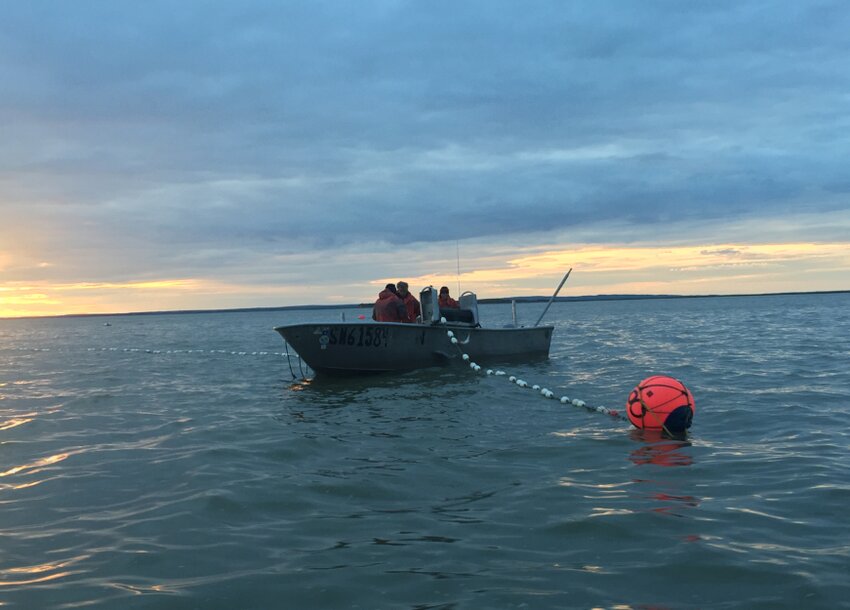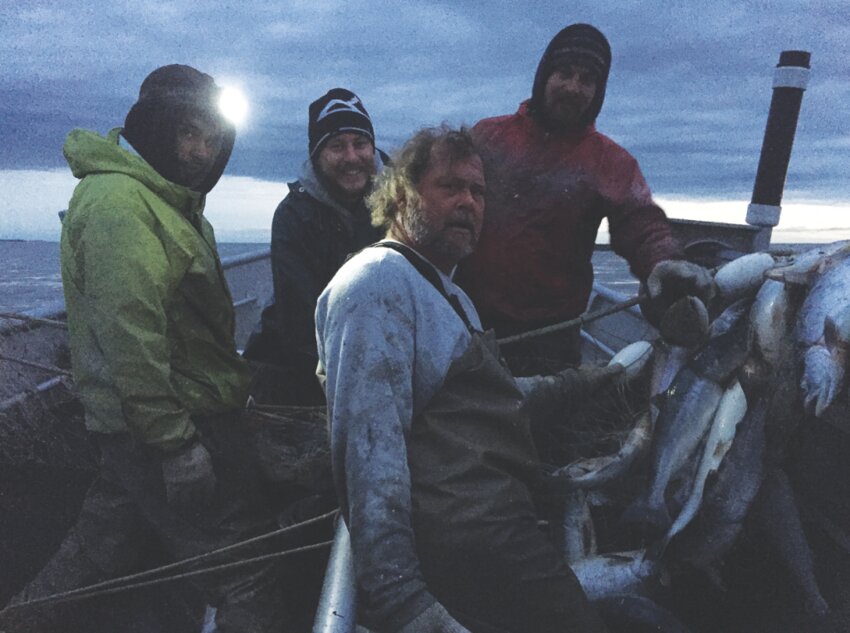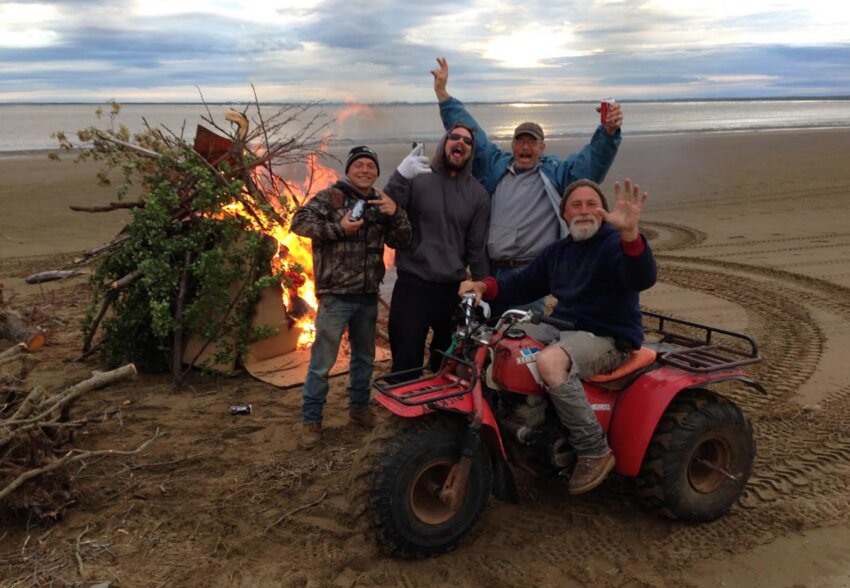July 22
Every other wave sent a wall of green spraying over the bow. The electric bilge pump couldn’t keep up, and water was pooling in the stern. “Take the wheel,” Captain Jerry said, before digging a blue water cooler from under a pile of gear and using it to bail.
We were halfway across Kvichak Bay in southwestern Alaska. Our 22-foot open aluminum skiff wallowed under a heavy load of camping and sockeye salmon fishing gear. I squinted into the wind, rain and spray, aimed toward Peterson Point, and cut into the big waves to keep us from swamping.
The calmer waters of the Naknek River were still an hour away and we were burning through gas. I focused on the horizon and hoped for better weather. Jerry seemed unconcerned.
“I don’t know why, but every year it decides to storm on the day we leave Graveyard Point,” he said.
I looked back at the faint smudge of land on the otherwise blank horizon. Graveyard Point, a collection of disintegrating wooden buildings and machinery that was once a cannery, had been our home, and home to a hundred other fishermen, for the past six weeks. I could see the other boat far behind us, with Captain Kris, Mike and Caleb making slow but steady progress against the storm. Seven weeks ago, we were all strangers except for co-owners/operators Kristina and Jerome. Now, we were like a family. The season was over, and we were all looking forward to sleep, cold beers and the comforts of home.
Seven weeks earlier… June 8
The flight into King Salmon was full of fishermen. Everyone was wearing Xtratuf rubber boots and Grundens rain jackets, and almost everyone was bearded and burly.
I found Kris outside the tiny airport in her 1994 blue Ford Ranger. Not a single car was in the parking lot – just old pickup trucks.
We drove the straight road across the tundra to Naknek, me asking dumb questions about the job I had been hired for, courtesy of Craigslist, and Kris smiling at my greenhorn questions and chain-smoking Capris.
“I forgot to bring bug spray … is that going to be a problem?” I asked.
“We have enough bug spray for a small army,” Kris said with a laugh. “I will die before we ever run out.”
We arrived at Red Salmon Cannery and thus began a two-week purgatory of preparing for the sockeye salmon fishing season. We lived in a smelly bunkhouse with the rest of the set-net fleet. Kris and Jerry had one room and our crew of four shared another.
We spent every day gathering gear from its various hidey-holes around Naknek, and staging, cleaning, repairing and re-staging it from sunup to sundown – a long day in the Alaskan summer. Jerry’s dog Jack, beers by the barrel fire at night and a wood-fired sauna behind the bunkhouse took the edge off, but the work was tough. By the end of two weeks, one guy was fired and another had quit, and the crew was down to Mike and me.
Mike goes by many names: Nitro, Moose, they all seem to fit his 6'5", 260-pound frame. Early on he earned his nickname from the other set netters – The Viking – and from Kris: Godzilla. He looks like a rugged, wild Alaskan fisherman, but he’s friendly, humorous, laid back and extremely hard working.
Mike has worked nearly every fishery in Alaska, from crabbing to seining, and makes good money dragging for pollock out of Kodiak in the winter months. He was looking for a relaxing summer job, and set netting for sockeye while living in an abandoned cannery sounded interesting.
The night before heading out from Naknek to Graveyard Point, Mike and I went down to the dock to check on the skiffs, which were fully loaded and anchored offshore. We knew we were in for a tough season, with only the two of us to do the work of a four-man crew.
“We are going to work our asses off,” Mike said. “But I’m telling you right now, we’re going to kill a lot of fish. We’re going to hit a hundred grand.”
 Mike's hands, missing part of a finger from a seining accident.
Mike's hands, missing part of a finger from a seining accident.A hundred thousand pounds of fish is a lofty goal for a four-man set net crew, let alone the two of us, but Mike’s determination was contagious.
There was no going back.
June 24
The spawning run of sockeye salmon in Bristol Bay is one of the great spectacles of nature. Every summer, millions of salmon leave the deep ocean and travel hundreds of miles to spawn and die in the rivers where they were born. The run lasts a few weeks, and at its height the creeks and rivers of Bristol Bay seem to boil with fish.
The Alaska Department of Fish and Game counts the fish escaping upriver and opens the fishery only when they are sure a healthy number will make it to the spawning grounds. Anyone caught fishing outside the open periods or outside their designated area is subject to major fines, and the authorities keep careful watch with boats, planes and helicopters. For this reason, Bristol Bay is often called the best-managed fishery
in the world.
In Bristol Bay there are two types of fishing: drift gillnetting and set gillnetting. Most of the annual catch is given over to drift gillnet boats, live-aboard vessels that drag long gillnets behind them. Set gillnetters operate along the shoreline using 20-foot aluminum skiffs to set stationary nets, held in place with anchors and buoys perpendicular to shore.
 Set net fishing at dusk.
Set net fishing at dusk.With a record run predicted for the season, Kris and Jerry knew we needed another crewmember to maximize our catch. Mike knew just the guy – his nephew Caleb.
After several phone calls, a missed flight and some taxi problems in the strange town of Naknek, Caleb made it to Red Salmon Cannery and we made a run across the bay to pick him up. Caleb was at first a little skeptical about the whole adventure, especially the dumpy cannery quarters. When Mike assured him Graveyard Point was worth the trouble, Caleb smiled and shrugged ok.
“It’s not like I can hitchhike my way out of here,” he said. A stylish, half-Mexican 19-year-old from Anchorage, Caleb has his uncle’s sense of humor and a quiet intelligence beyond his years. In other ways, he’s a typical 19-year old: focused on girls, looking to get new rims for his Tahoe and occasionally getting into trouble along with his friends.
We were now a crew of three, with two solid captains and everything we needed for the season in place at Graveyard Point. If the fish came, we were ready.
June 28
We had been in Graveyard Point about a week before we heard the announcement from the Alaska Department of Fish and Game (ADFG) that our area would finally open to set netters. We geared up, loaded the boats and headed out of Graveyard Creek to the sites a few miles down the bay.
With the net stacked cleanly in the bottom of the boat so as not to snag, Jerry maneuvered the boat up to the shore-side buoy. We hooked one end of the net onto the buoy, then used a sliding knot to tie the other end of the net to the running line, a 150-foot line connecting the shore-side buoy to the outside buoy.
I stood in the bow holding on to the sliding knot, and Jerry drove the boat across to the outside buoy as the net unfurled out the back of the skiff. It sounds simple, but in tidal currents as fast and strong as the Colorado River, it takes coordination and timing to make a good set. Jerry had to drive fast to get to the outside buoy before the current put too much tension on the net, but not so fast that we couldn’t slide the knot or catch the buoy when we got there. Jerry is an expert skiff driver, and I learned my job pretty quickly.
Kris and Mike were in the other boat fishing two nets set end-to-end, and Caleb would switch boats to help whoever needed him the most. It only took a few tides to learn that Kris’ shore-side net was the money net – the salmon love to cruise the shallow water, and they started slamming the net as soon as the tide flooded in.
 Hauling in the net.
Hauling in the net.Depending on how hard the fish were hitting, we would either start picking fish right away or let the nets soak awhile. To pick up the net, Jerry drove up slowly as I reached down over the bow with a boat hook, snagged the net and pulled it up over the bow. We lifted the net onto a hydraulic power roller so it lay across the middle of the boat. We pulled net in one side of the boat while feeding it out the other side, stopping every few feet to pick fish, and moving the boat sideways as we worked from one end of the net to the other.
Picking fish is an art and a science, and I learned from a master. If a fish was simply caught by its gills in one mesh, it was no problem to flick it out of the net, but more often the fish would wrap themselves up in their struggle, hooking themselves multiple times and forming a heinous basket of web. Jerry was the basket weaver, flipping and spinning the net until the fish simply dropped to the deck. It took me awhile, but eventually I got “net-vision,” allowing me to see how to untangle the fish most efficiently. When the net was plugged with fish, it took teamwork to flip huge plugs of fish out of the net and apply tension or slack to make it easier for everyone else to pick their fish.
Mike was a monster fish-picker, earning the Godzilla moniker by simply throwing the fish out of the net with brute strength. Caleb didn’t come to it right away. It took some lecturing from Jerry, but before too long Caleb was picking fish like a seasoned pro.
For the first week of fishing, we were allowed to fish one tide per day – “gentleman fishing,” Kris called it. We had some big tides that first week, and when they finally gave us a 24-hour opener, we caught 11,000 pounds in one day of hard fishing.
 Delivering to the tender.
Delivering to the tender.We delivered multiple times per tide to a tender boat, which uses cranes to lift and weigh bags full of fish before dropping them into a refrigerated holding tank. As the run started hitting full steam, the canneries limited the pounds we could deliver per tide. Eventually, Kris and Jerry decided to work only on Kris’ nets so we wouldn’t go over our limits.
Nearly every tide we dealt with the inevitable curveballs fishing throws your way: tangled running lines, nets in the propeller, running aground or equipment failures. In the space of one tide, the pull cord for the hydraulic power pack, the outboard throttle cable and the trim switch all broke on Jerry’s boat. Luckily, after 15 years of this, Jerry can fix almost everything on the boat with minimal tools.
The days flew by as our openers went up to 48 hours, then 72 and finally the escapement numbers were reached and we had open season. This was good and bad. It was good because we could fish all we wanted. It was bad because we wanted to fish all the time, and things like eating and sleeping were secondary to hitting our goal of 100,000 pounds. We would fish the flood, fish the ebb and come back to Graveyard for an hour or two of sleep before heading out again. Our lives depended on the tides, not the rising and setting sun.
 Plugged net at 3 a.m. From l., Caleb, Ian, Captain Jerry and Mike.
Plugged net at 3 a.m. From l., Caleb, Ian, Captain Jerry and Mike.July 15
At 2:45 a.m. the loud alarm perched next to my ear went off, and I sat up with a thousand-yard stare across the pitch dark room. Caleb cursed. Jerry busted into the room, shirtless and bug-eyed, with hair standing up at all angles.
“It’s time to feesh!” he yelled in a crazed, faux-Mexican accent. Kris was in the kitchen standing next to the propane heater like it was her best friend in the world, and Jack was running around trying his best to convince us that he could fish even though he lacked opposable thumbs. We stumbled around chugging coffee, putting on our waders, rain gear, gloves and headlamps, and rolling a few last-minute cigarettes for the tide. We wolfed down whatever delicious leftovers were on the table and practically jogged down the long, broken boardwalk to the boats.
For two weeks we fished every tide, then finally we missed a tide when everyone slept through five alarms from pure exhaustion. We were well on our way toward 100,000 pounds, but it was going to be close. At the the end of the season, Mike was the main motivator:
“The fish are slamming. We need to get those nets in for the flood. We’re getting a hundy, bro!”
Sleep deprivation set in. Once, Caleb and I sat at the table laughing for 10 minutes for no reason. Most of the crew got numb fingers from the sheer labor of pulling nets and picking fish. Tempers boiled over occasionally, with loud arguments, threats to quit and hurled insults. It’s inevitable when you’re working that hard for that long in tight quarters without any sleep. Things always calmed down when we got back on land.
We ate like royalty. Kris and Jerry packed a freezer and boxes full of easy-to-prepare meals, and we hauled a kitchen’s worth of appliances, and the generator to power them, out to the cabin. Meatloaf, pulled-pork sandwiches and biscuits and gravy were the norm. We ate salmon in all forms. Mike made a mean ceviche, and he and Caleb taught me how to gut, fillet and smoke salmon, some of which I brought home.
End of the season – July 22
The 2015 sockeye salmon run in Bristol Bay set records with a late and massive run. In the end, we caught 101,157 pounds. Everyone caught a lot of fish, but due to the large catch and various geopolitical factors, the canneries set a price of $0.50 per pound. For reference, the 2014 price was $1.25 per pound. Needless to say, there were a lot of disappointed fishermen at the bars in Naknek when we got back.
 Fourth of July bonfire with the Biskey crew.
Fourth of July bonfire with the Biskey crew.It was an adventure. We tooled around the tundra on a four-wheeler for firewood-gathering missions. We hung out with the Biskey crew, a family from northern Minnesota who love to drink beers and have a good time, and had a rowdy Fourth of July bonfire, complete with fire walking and wrestling that brought a crowd to the beach. We saw families of huge brown bears, beluga whales, seals and bald eagles. No one got hurt, although I still can’t feel my fingers.
The biggest thing I got out of the trip was a lifelong friendship with four of the craziest, toughest Alaskans you’ll ever meet. Will I go back to Graveyard? At the moment it’s hard to imagine doing it again. Worked out hourly, the pay was probably less than minimum wage. Even Mike said it’s the hardest job he’s ever had for the money. But commercial salmon fishing is always a gamble. Come April, I’m sure I’ll be missing Bristol Bay. And who knows? It could be a good year for salmon. x